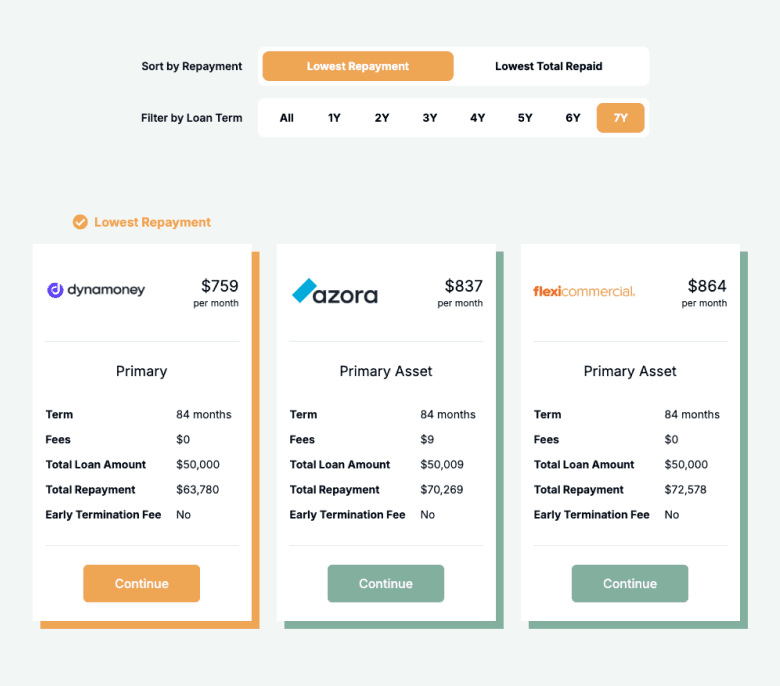Compare Asset Finance from 50+ Australian Lenders
Acquire vehicles, machinery, equipment and more without tying up capital. Compare real quotes in minutes with no impact on your credit score.
5.0 rating


Asset Finance Made Simple
Finance a wide range of assets — from vehicles to IT infrastructure — with tailored solutions that help Australian businesses grow without draining cash flow.
Borrow With Confidence
Amounts from $10,000 to several million
Flexible Terms
Loan terms from 1 to 10 years
Fast Approval
Funding often within 24–72 hours
Secured by Asset
The asset itself acts as collateral
Industry Coverage
Transport, agriculture, construction, IT, medical and more
Tax Benefits
Interest and depreciation may be deductible
How Asset Finance Works
We connect you with lenders offering tailored asset finance so you can fund essential purchases quickly and confidently.
Apply online in minutes
Tell us about your business and the asset you need.
Get matched offers
Receive tailored quotes from multiple lenders across Australia.
Choose your loan
Compare interest rates, fees and repayment terms to find the best fit.
Get approved & funded
Approval and settlement often within 24–72 hours.

A quick guide to asset finance
Asset finance helps Australian businesses acquire critical equipment and infrastructure without large upfront costs. Repayments are spread over time, freeing cash for working capital and growth.
Loans are usually secured against the asset, reducing lender risk and delivering sharper pricing compared to unsecured products. Terms typically range from 1 to 10 years, with repayment structures tailored to cash flow.
Assets that can be financed include vehicles, construction machinery, IT systems, medical technology, manufacturing equipment, renewable energy installations and even commercial property. Whether you’re modernising infrastructure, upgrading vehicles, or expanding operations, asset finance ensures you have access to the resources you need.
The advantage is flexibility: you gain immediate use of the asset, while repayments align with the income it generates. This keeps cash flow predictable and allows businesses of all sizes to remain competitive and agile.
Want to skip ahead?
This guide is broken down into the following sections. Click a link if you want to skip ahead.
Types of asset finance
The main types of asset finance available to Australian businesses are:
Chattel Mortgage
A secured loan where you own the asset from day one while the lender holds a mortgage over it as security. Perfect for business equipment, vehicles, and machinery purchases.
Pros
- Immediate ownership of the asset
- Tax benefits - claim GST credits and depreciation
- Flexible repayment terms available
- Lower interest rates due to security
Cons
- Asset serves as security - risk of repossession
- Comprehensive insurance typically required
- Ongoing maintenance responsibilities
Best For
Established businesses looking to purchase equipment, vehicles, or machinery with immediate ownership and maximum tax benefits.
Hire Purchase
A financing arrangement where you hire the asset with an obligation to purchase it at the end of the term. Combines the benefits of gradual ownership with manageable monthly payments.
Pros
- Guaranteed ownership at term completion
- Fixed monthly payments for budgeting
- No large upfront capital required
- Tax benefits available during the term
Cons
- No ownership until final payment made
- Higher total cost than outright purchase
- Asset cannot be sold during the term
- Early termination may incur penalties
Best For
Businesses that want eventual ownership of assets but need to spread the cost over time, particularly suitable for essential equipment with long useful life.
Finance Lease
A lease agreement where you use the asset throughout the lease term with the option to purchase it at the end. Ideal for businesses wanting to preserve cash flow while accessing essential equipment.
Pros
- Lower upfront costs and deposits
- Preserves working capital and credit lines
- Tax deductible lease payments
- Option to purchase at lease end
Cons
- No ownership until lease completion
- Total cost may be higher than outright purchase
- Early termination penalties may apply
Best For
Growing businesses that need equipment access without large capital outlay, or companies wanting to preserve cash flow for operations.
What can I use asset finance for?
Asset finance is versatile and can be used for many business needs:
Vehicles
Fund cars, vans, trucks and specialised vehicles for business operations.
Machinery & Equipment
Purchase essential tools and equipment for construction, agriculture or manufacturing.
Technology & IT
Finance computers, servers, software, and communication systems.
Office Furniture
Acquire desks, chairs, shelving, fixtures and fittings for your workplace.
Construction Equipment
Fund excavators, cranes, loaders, bulldozers and other heavy machinery.
Commercial Property
Acquire or develop warehouses, retail spaces, or office buildings.
Manufacturing Equipment
Finance specialised production lines, tools or CNC machinery.
Medical Equipment
Fund diagnostic devices, surgical tools and patient care systems.
Hospitality Equipment
Acquire commercial kitchens, refrigeration and fit-out equipment.
Renewable Energy
Invest in solar panels, wind turbines and sustainable energy solutions.
Case Study

David Harris, Northern Freight Solutions
Growing a Transport Fleet with Asset Finance
Industry: Transport & Logistics
Challenge: Limited fleet size meant turning down contracts and missing growth opportunities.
Solution: A 5-year chattel mortgage secured against three prime movers and trailers.
David runs a freight company in South Australia. Demand was growing, but he lacked the fleet capacity to service new contracts. Through Emu Money, he secured asset finance for three prime movers and trailers under a 5-year chattel mortgage. Repayments were structured monthly, aligned with invoicing cycles. The new fleet allowed him to take on major clients, expand routes, and double turnover within 18 months — all while maintaining predictable repayments.
How much can I borrow with asset finance?
In Australia, asset finance typically ranges from $10,000 for smaller purchases up to several million dollars for large-scale projects. The borrowing amount depends on the type, value and expected life of the asset, as well as your business’s financial position.
Lenders usually consider the resale value and income-generating potential of the asset when deciding limits. Because the loan is secured against the asset itself, approval is often simpler and pricing more competitive compared to unsecured loans.
Asset Finance Repayment Calculator
Estimate repayments and total cost. Adjust the loan amount, term and rate to plan your budget before you apply.
Balance over time
Am I eligible for asset finance?
Eligibility is generally straightforward, as the asset provides collateral. Lenders assess turnover, bank statements and repayment history when reviewing applications.
You may be eligible if you are:
An Australian citizen or permanent resident
Over 18 years old
Operating a registered business
Able to provide recent financials or bank statements
Hold an ABN (and GST registration if required)
How to apply for asset finance
Apply online in minutes and get instant quotes from our panel of lenders. Choose the best option, submit documents, and funding can often be arranged within 24–72 hours.
Documents you may need:
ABN and GST registration details
Photo ID (passport or driver’s licence)
Recent bank statements
Tax returns or financials (for larger loans)
How to save money on asset finance
The total cost of asset finance depends on loan term, rate, and repayment frequency. Shorter terms reduce overall interest but increase monthly outgoings, while longer terms ease cash flow but increase total costs.
Compare multiple lenders to secure the sharpest deal. Watch for hidden costs like establishment, documentation, or early termination fees. Align repayment schedules with revenue cycles to reduce stress and late fees. Where possible, make additional repayments to cut down interest.
Understanding asset finance options
Asset finance products can differ significantly in structure. Here are key features to understand before choosing:
Security: Asset-backed
Most asset finance loans are secured against the asset itself. This reduces lender risk, supports higher borrowing limits, and allows for more competitive interest rates compared to unsecured facilities.
Personal Guarantee
Directors or owners may be asked to provide a personal guarantee. This makes you personally responsible if repayments aren’t met, reducing lender risk but enabling access to sharper terms.
Term & Balloon
Asset finance terms generally run 1–10 years. A balloon or residual payment can reduce regular instalments, but you’ll need to pay or refinance the lump sum at the end of term.
Interest Structure
Most facilities use fixed interest rates, offering repayment certainty. Some lenders also provide variable options, which may start lower but can fluctuate. Compare carefully to match risk tolerance.
Fees & Charges
Fees can include establishment, documentation, ongoing service and early payout charges. Always calculate the true cost of borrowing, not just the interest rate, to avoid unexpected expenses.
Repayment Frequency
Repayments can be scheduled weekly, fortnightly, monthly or seasonally. Choosing a structure that aligns with your business’s revenue cycle ensures smoother cash flow management and fewer late fees.
Testimonials
Verified Review
Stevie was amazing she made the entire process smooth, not stressful and easy everything she requested wasn’t hard to complete, she worked around me she gave me advice or what to look for in a car she shared some good places to find a car she shared her experience with insurance she was amazing and went above and beyond. It isn’t always easy sharing things with someone when it comes to your personal affairs but she made me feel welcome to share you have a start worker and I really do believe she deserves a pay bonus
Tania W.
Verified Review
I've got the best service at Emu Money and their willingness to help you out. Evette went out of her way to help assist for the desired results. I will highly recommend them to anyone. Evette's industry knowledge & service was exceptional! I highly recommend her & will definitely reach out should we need any financial services in the future. Thank you
Mazhar A.
Verified Review
Theodore G.
Verified Review
I had an excellent experience with Emu Money. Robyn was fantastic – professional, approachable, and genuinely easy to deal with from start to finish. She explained everything clearly, made the whole process stress-free, and went above and beyond to ensure I was comfortable with each step. It's rare to find someone so reliable and efficient. I'd highly recommend Emu Money, and especially Robyn, to anyone looking for great service and peace of mind
Cruize W.
Verified Review
We have received a tremendous service from Geetu and team they have helped us smoothly in getting the loan approved. I will definitely recommend to my friends and family.
Kiranjit K.
Verified Review
Awesome to deal with. Brad was fantastic, nothing was too much trouble, handled all the hard work and let me get on with my business. Would totally recommend.
Charles L.
Frequently Asked Questions
Asset Finance FAQs
These helpful FAQs will help you find the answers you need. If you can't find what you're looking for, you can request a callback below.







































































